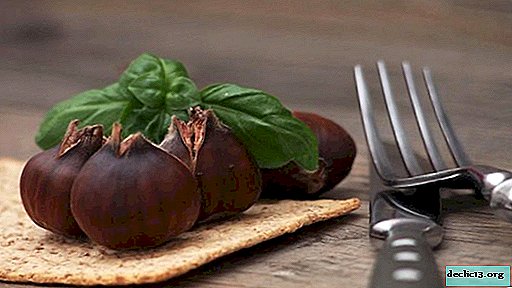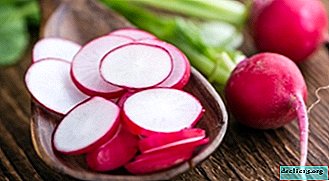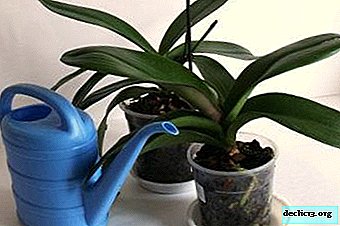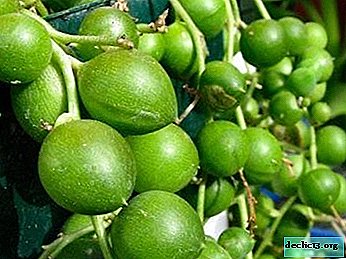What is catharanthus pink and how to care for it?
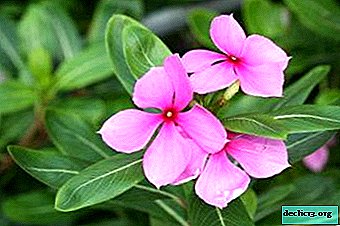
Katarantus pink is a delicate flower that has arrived in our gardens and flower beds from distant tropical countries. Thanks to the efforts of breeders, Periwinkle is successfully bred in domestic floriculture.
It is used as a medicinal and ornamental plant. You will learn about the beneficial properties of this beautiful flower, about methods of its propagation, growing conditions at home and in the open ground, and the rules for caring for it in our article.
Why has two names?
Is catarantus and periwinkle the same thing? Katarantus pink - a species of evergreen shrubs, perennial, belongs to the genus Katarantusov, a large family Kutrovy.
Among flower growers, it is more common under the name Periwinkle pink. Quite a long time, cataractus pink was considered a variety of periwinkle. Both plants belong to the same Kutrov family. In the mid-20th century, pink catharanthus was isolated by scientists as a separate genus of evergreen perennials.
ATTENTION: In nature, grows on the island of Madagascar, in India and in Cuba. It grows in Transcaucasia, Kazakhstan and the Kuban. This flower is grown as a medicinal raw material. In the northern regions of our country, periwinkles are grown as a decorative annual.Description of the pink look
Katarantus pink - undersized perennial shrub. It grows to 30 - 50 cm in height. The stems can be straight or creeping, woody at the base.
The root is long, rod-like, light yellow, has many side branches - roots. The leaves are shiny, medium density, large, oblong, blunt, bright green. In length, the leaves grow to 8-10 cm, in width - 3 - 3.5 cm.
Petioles of leaves are short, thick; leaves grow opposite. A feature of the structure of the leaf is a clearly defined venation over the entire surface of the leaf. The central vein is white.
Catharanthus flowers are white, all shades of pink are found. The corolla has the shape of an ear, consists of 5 petals that grow together into a tube, the throat of the corolla has a pronounced purple hue. The flowers are medium, up to 3-4 cm in diameter, the aroma of flowers is weakly expressed. In a temperate climate, seeds do not ripen.
Photo




Healing properties
- Katarantus pink - widely used in traditional medicine. In modern pharmacology, special vigorous antitumor drugs are created from the raw materials of Periwinkle, used in the treatment of oncological diseases: hematosarcoma, etc. Derived drugs affect the metabolism of amino acids - the antitumor function. The latest semisynthetic preparations of a new generation are developed on the basis of pink catharanthus.
- The periwinkle contains many trace elements - zinc, iron, calcium, magnesium, etc. It must be remembered that cataractus pink is a poisonous plant, it is contraindicated to self-medicate. The use of drugs or infusions of herbs is necessary only under the strict supervision of doctors. In addition to drug function, there are many side effects, contraindications.
- Herbalists use the flower as an antibacterial agent. Also, the shrub has a healing effect on prostatitis of any stage. On its basis, drugs contribute to healing without surgery.
- With the help of pink cataranthus, various female uterine pathologies are cured: polyps in the ovaries and uterus resolve. With proper treatment, aggressive cells are destroyed, they do not allow them to degenerate into new tumors.
- Also, the flower has antimicrobial strength, relieves purulent wounds, heals even gangrene in the initial stage. It activates blood circulation, which contributes to tissue repair.
- Katarantus pink relieves non-overgrowing external ulcers, even when neglected.
- Stops inflammatory processes of the gastrointestinal tract.
- It copes well with skin diseases - eczema, fungi, irritation with insect bites.
- Lowers blood sugar.
- Flower extract treats pneumonia and pulmonary tuberculosis.
- Herbalists use decoctions for toothache.
Rules for the care and cultivation of a herbaceous plant
For open ground
 Katarantus is a pink unpretentious flower, it can be planted by a novice grower, given the simple rules of care.
Katarantus is a pink unpretentious flower, it can be planted by a novice grower, given the simple rules of care.
The planting site should be bright, warm, with enough sunlight, but not direct, so as not to burn the leaves. The main thing is to protect undersized bushes from gusts of cold wind and drafts.
The soil should be acidic, without excessive salt deposits, well-fertilized, breathable. The main thing is not to plant pink Catharanthus close to each other to avoid stagnation of air and moisture.
The composition of the soil mixture for catharanthus pink:
- Horse peat - 1 h.
- Humus - 1 hour
- Sod land - 1 h.
- Sheet land - 1 h.
- Sand - 1 hour
Katarantus pink - thermophilic flower, the temperature of the maintenance of bushes - 26 - 27 º C in the summer. A temperature reduced to 10-8 ° C can hold the flower in bloom and growth.
More information about the rules of planting and further care for catharanthus in the open ground can be found here.
For indoor flower
As a houseplant, catharanthus pink has been grown for several years, it is a perennial. In the apartment it is advisable to install pots and flowerpots on the eastern and western windows.
In summer, it is advisable to obscure windows from direct sunlight. The capacity for planting is chosen quite voluminous, deep, given the structure of the massive long root. In the design of apartments and loggias, catharanthus is used in hanging baskets and pots..
IMPORTANT: The flower grows rapidly, every year it requires a transplant in a more spacious pot. For transplanting into pots, flower growers recommend using a soil mixture for geraniums. It can be bought at a special store.Also, the soil mixture can be done independently. Substrate for indoor cultivation of Catharanthus rosea:
- Sheet land - 1 h.
- Sod land - 1 h.
- Peat - 0.5 hours
- River sand - 0.5 hours
 Growing a flower in a home environment is easy. Watering is plentiful, regular spraying is required; feeding with mineral fertilizers is required once every 2 to 3 weeks.
Growing a flower in a home environment is easy. Watering is plentiful, regular spraying is required; feeding with mineral fertilizers is required once every 2 to 3 weeks.
To maintain humidity, flowerpots can be installed on a pallet with wet expanded clay. The optimum humidity is 60%.
In summer, it is advisable to take out the pots in the fresh air, on the balcony or loggia. In spring, pruning of overgrown stems is required by a third. In winter, the air temperature should not drop below 10 º C. The optimum temperature in the housing conditions is up to 20 - 22 º C.
Catharanthus pink propagates in several ways.
Preparing for the winter
As soon as it gets colder outside, in September - October, it is better to bring flower pots into the house. Then the flowering of Catharanthus pink will last.
In winter, flowerpots are installed in a cool and bright room.. The optimum winter temperature for the flower is 12-15 ° C.
Watering is reduced by 2 times, the substrate should be slightly moist. If the air is dry, spraying the leaves is required.
In winter, daylight hours are short; there may not be enough light for pink cataranthus.. It will require additional illumination with special phytolamps for several hours a day.
Breeding
Sowing seeds
- Held in early spring, in March.
- In a special box - a greenhouse, drainage is laid out, a small layer of a special substrate.
- Sow seeds to a depth of 1.5-2 cm.
- Sowing is covered with a dense film or glass.
- Germination air temperature - 24 ° C.
- It is enough to moisten the crop by ventilating the greenhouse regularly.
- The first shoots appear within 7-9 days.
After seed germination, the boxes are exposed, and the air temperature must be reduced to 18 - 20 º C. After 2 - 3 weeks, feeding of pink cataranthus sprouts is desirable. It is better to use nitrogen fertilizers to grow leaves. Seedlings should be dived when 3 to 4 true leaves appear on a sprout 7-8 cm high.
Watch a video about growing pink catharanthus from seeds:
You can learn more about how to grow a catharanthus from seeds at home in this material.
Cuttings
Held in the spring:
 The apical cuttings 6-7 cm long are cut obliquely.
The apical cuttings 6-7 cm long are cut obliquely.- Place the cuttings in water or in clean, washed sand.
- Be sure to cover the seedlings with a glass jar.
To obtain a lush, compact bush, it is recommended to pinch the tops of seedlings. The procedure is carried out 1 to 2 times. When the seedlings take root, they are dived into peat cups and planted in open ground when spring heat is established. Seedlings are planted at a distance of 30 - 50 cm.
The peculiarity of the flower is that cataractus pink quickly takes root, the root develops well with sufficient moisture in the substrate and good lighting.
Watch the video on the propagation of pink quarantus by cuttings:
Dividing the bush
- Bushes easily tolerate the division of the mother bush.
- The procedure is carried out in early spring.
- The bush is divided into separate parts with the preservation of the earthen coma and part of the healthy, intact root processes.
- Separated parts quickly take root, begin to grow both in flowerpots and in open flowerbeds.
Katarantus is a poisonous flower, so when planting, pinching, grafting, work with gloves, Prevent the flower juice from getting into the eyes and skin. Wash hands thoroughly after handling.
Watering the catharanthus pink should be a whole year. Drying of the soil is unacceptable, but waterlogging of the substrate leads to diseases and death of the flower. Immediately after watering, the water from the pan must be poured so that the roots do not get wet.
ATTENTION: Summer spraying is acceptable to maintain sufficient air humidity.In autumn, in rainy weather, the flower can slow down in growth. To prevent rot and getting wet, when planting, do not thicken the bushes, it is necessary to leave a distance between the planting holes of at least 30 - 40 cm (more about planting features, cultivation of cataranthus and plant care can be found here).
You should feed the flower every 10 to 14 days with complex balanced fertilizers, starting from the moment of flowering.
Katarantus pink, in addition to its main purpose - the treatment of many diseases, is also an excellent decoration of terraces and flower beds, covering the front gardens and flower beds with a bright dense carpet.

 The apical cuttings 6-7 cm long are cut obliquely.
The apical cuttings 6-7 cm long are cut obliquely.
